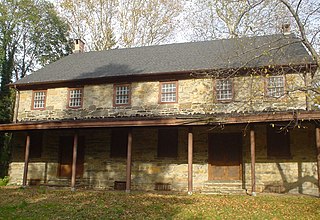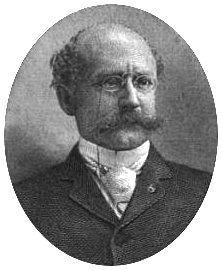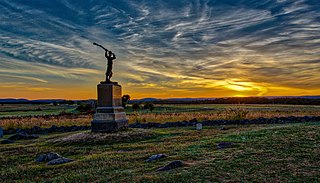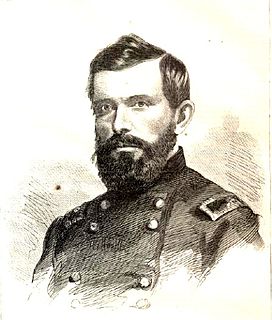Lieutenant Colonel Charles Kochersperger (1826—1867) was a Union Army officer with the 71st Pennsylvania Infantry Volunteers Regiment. He was the unit's second-in-command at the 1863 Battle of Gettysburg and its commander at the 1864 Battle of the Wilderness. [1]

During the American Civil War, the Union Army referred to the United States Army, the land force that fought to preserve the Union of the collective states. Also known as the Federal Army, it proved essential to the preservation of the United States of America as a working, viable republic.
The Union order of battle during the Battle of Gettysburg includes the American Civil War officers and men of the Army of the Potomac (multiple commander names indicate command succession of command during the three-day battle . Order of battle compiled from the army organization during the battle, the casualty returns and the reports.
Kochersperger was born in Philadelphia, Pennsylvania, on February 8, 1826, the eldest son of Charles Kochersperger by his wife Jane, ‹See Tfd› née McDonnell. He was married there on July 4, 1849, to Sarah Ann Bozorth of the same place.

Philadelphia, sometimes known colloquially as Philly, is the largest city in the U.S. state and Commonwealth of Pennsylvania, and the sixth-most populous U.S. city, with a 2017 census-estimated population of 1,580,863. Since 1854, the city has been coterminous with Philadelphia County, the most populous county in Pennsylvania and the urban core of the eighth-largest U.S. metropolitan statistical area, with over 6 million residents as of 2017. Philadelphia is also the economic and cultural anchor of the greater Delaware Valley, located along the lower Delaware and Schuylkill Rivers, within the Northeast megalopolis. The Delaware Valley's population of 7.2 million ranks it as the eighth-largest combined statistical area in the United States.

Pennsylvania, officially the Commonwealth of Pennsylvania, is a state located in the northeastern and Mid-Atlantic regions of the United States. The Appalachian Mountains run through its middle. The Commonwealth is bordered by Delaware to the southeast, Maryland to the south, West Virginia to the southwest, Ohio to the west, Lake Erie and the Canadian province of Ontario to the northwest, New York to the north, and New Jersey to the east.
In 1855, he purchased a private mail delivery company, Blood's Penny Post, which issued its own postage stamps and competed directly with the United States Postal Service. It would eventually be shut down by a Supreme Court of the United States decision.

The United States Postal Service is an independent agency of the executive branch of the United States federal government responsible for providing postal service in the United States, including its insular areas and associated states. It is one of the few government agencies explicitly authorized by the United States Constitution.

The Supreme Court of the United States is the highest court in the federal judiciary of the United States. Established pursuant to Article III of the U.S. Constitution in 1789, it has original jurisdiction over a small range of cases, such as suits between two or more states, and those involving ambassadors. It also has ultimate appellate jurisdiction over all federal court and state court cases that involve a point of federal constitutional or statutory law. The Court has the power of judicial review, the ability to invalidate a statute for violating a provision of the Constitution or an executive act for being unlawful. However, it may act only within the context of a case in an area of law over which it has jurisdiction. The Court may decide cases having political overtones, but it has ruled that it does not have power to decide nonjusticiable political questions. Each year it agrees to hear about 100–150 of the more than 7,000 cases that it is asked to review.
In 1861, he enlisted with the 71st Pennsylvania Volunteers Regiment. He rose to second-in-command by Gettysburg and full command for the Wilderness, where he was severely wounded. Kochersperger died from the long-term effects of his war wounds in Philadelphia on December 26, 1867, and was buried on Dec. 29 at the city's Odd Fellows Cemetery, now defunct.

The Gettysburg Campaign was a military invasion of Pennsylvania by the main Confederate army under General Robert E. Lee in summer 1863. The Union won a decisive victory at Gettysburg July 1–3, with heavy casualties on both sides. Lee managed to escape back to Virginia with most of his army. It was a turning point in the American Civil War, with Lee increasingly pushed back toward Richmond until his surrender in April 1865. After his victory in the Battle of Chancellorsville, Lee's Army of Northern Virginia moved north for a massive raid designed to obtain desperately needed supplies, to undermine civilian morale in the North, and to encourage anti-war elements. The Union Army of the Potomac was commanded by Maj. Gen. Joseph Hooker and then by Maj. Gen. George G. Meade.

The Battle of the Wilderness, fought May 5–7, 1864, was the first battle of Lt. Gen. Ulysses S. Grant's 1864 Virginia Overland Campaign against Gen. Robert E. Lee and the Confederate Army of Northern Virginia in the American Civil War. Both armies suffered heavy casualties, around 5,000 men killed in total, a harbinger of a bloody war of attrition by Grant against Lee's army and, eventually, the Confederate capital, Richmond, Virginia. The battle was tactically inconclusive, as Grant disengaged and continued his offensive.
Odd Fellows Cemetery was a cemetery at 24th and Diamond Streets in Philadelphia, established in 1849 and destroyed in the 1950s.
His widow survived him by 45 years, dying in Darby, Pennsylvania, on April 14, 1912.

Darby is a borough in Delaware County, Pennsylvania, United States, along Darby Creek 5 miles (8.0 km) southwest of Center City, Philadelphia. Darby was settled about 1654 and inhabited by Quakers early in the colonial era. Incorporated on May 3, 1853, it had 3,429 residents in 1900, 6,305 in 1910, 10,334 in 1940, and 10,687 at the 2010 census.












